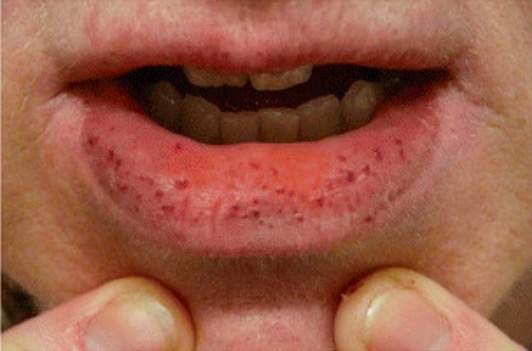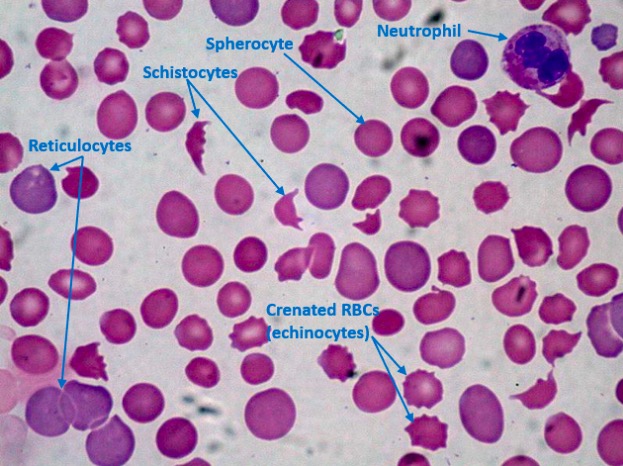Playlist
Show Playlist
Hide Playlist
Bleeding Disorders: Vessel Wall Abnormalities
-
Slides BleedingDisorders QuantitativePlateletAbnormalities.pdf
-
Download Lecture Overview
00:01 Let's take a look at bleeding disorders. 00:02 We'll first take a look at quantitative. 00:05 In other words, we find a decrease in number of platelets and our differentials are the following. 00:12 The platelet abnormalities that we'll take a look at, well, you can either have functional issues, right? Or maybe you might actually have a decrease in platelet count. 00:22 In either case, when you have a platelet abnormality, then what is the test that you're going to refer to? Good, your bleeding time is what we should take a look at. 00:34 In our previous discussions, we've had adhesion with von Willebrand factor, glycoprotein Ib. 00:39 We've had activation with ADP playing the role with the receptor called P2Y12 receptors. 00:45 And we talked about aggregation with glycoprotein IIb/IIIa being expressed by the platelets and it binding to fibrinogen or fibrin. 00:54 In any one of those points here, if they become dysfunctional, we have an abnormality, ladies and gentlemen. 01:01 Under quantitative, what does that mean to you? Well, we have a decrease in platelet count. 01:07 So, obviously, the suffix we're gonna use here is penia. 01:11 A platelet is referred to as being a thrombi so, thrombocytopenia. 01:17 You could either have decreased production or decreased survival, or at some point, we will later on talk about functional issues. 01:25 It could be inherited deficiencies, or maybe perhaps, even acquired. 01:28 In either case, we have all the different ways in which we could have platelet abnormalities. 01:34 Let's take a look at quantitative. 01:36 The platelet test that you wanna focus upon will be well, what is the number of platelets that we have? The minimum number that we should have is 150,000. 01:46 If it becomes clinically significant with thrombocytopenia, then, you're looking at 50,000. 01:53 Remember, the upper normal limit is approximately 400,000. 01:56 Remember, if platelet count or if platelets are not functioning properly, the test that you should be testing or looking for would be a bleeding test. 02:06 That bleeding test assists with the functionality of your platelet. 02:10 The time is two to seven minutes. 02:12 And if you wanna see as to whether or not you have proper adhesion. 02:16 For example, you have a lady who has severe menorrhagia. 02:21 You find an increase in bleeding time and an increase in PTT. 02:25 You were suspecting highly of that patient suffering from von Willebrand disease and you should be thinking about using a ristocetin cofactor assay or platelet aggregator. 02:37 Let's take a look at decreased platelet production to quantitative thrombocytopenia. 02:43 What if the bone marrow had been infiltrated by let's say chemotherapy? Or had been destroyed by Parvovirus B19? We then call this aplastic anemia, don't we? Which is a normocytic type of, nonhemolytic type of anemia. 03:00 Picture the bone marrow for me. 03:03 In your bone marrow should be spongey bone, correct? It should be filled with a little bit of fat, clear vacuoles, and you have your hematopoietic stem cells and the baby, or the maturing type of platelet is then referred to as your megakaryocyte. 03:18 Now, imagine the patient suffering from aplastic anemia, and obviously, you're gonna find a decrease in megakaryocyte which means that it translates into a decrease in platelet production. 03:29 Welcome to thrombocytopenia and increase in bleeding time, but obviously with aplastic, not only are you gonna decrease your platelet and your patient is bleeding, but then also, fatigue and tired, right? Because of no RBC production and could also be susceptible to infection because you don't have neutrophils, right? So keep things in perspective. 03:48 What if the bone marrow was infiltrated by oh, let's say in the Western hemisphere, we have for Western world, we have the most common infiltration would be maybe perhaps metastasis? You have a lady that has breast cancer, metastasizes into your bone marrow. 04:06 We call this myelophthisic anemia, don't we? Or let's say you have tuberculosis and you have a granuloma formation in your bone marrow. 04:15 Myelophthisic, or even leukemias. 04:18 And leukemias, yeah it may be perhaps. 04:21 It looks like it's hypercellular but the type of cells that you're producing, they're not proper. 04:26 Or myelofibrosis, what if that bone marrow was infiltrated by JAK2-STAT type of oncogenic production. 04:34 In other words, we have primary myelofibrosis being filled with fibrosis. 04:40 Or maybe perhaps there was storage disease. 04:44 Anyhow, the point is we could either have aplastic anemia where it's completely hypocellular, filled with fat only, or it could be bone marrow infiltration which we generically call myelophthisic resulting in decreased platelet production. 04:58 Or you could have what's known as myelodysplasia or megaloblastic anemia. 05:03 In other words, let's say that your patient has Vitamin B12 or Folate Deficiency. 05:08 If that's the case, then you don't have the equipment, right? Or the tools to properly form your cells, so therefore, you have these blasts. 05:16 And here once again, remember, with megaloblastic anemia, not only will you have issues with your megaloblast over your baby RBC's but you'll also have issues with Hypersegmented neutrophils and you might have decreased production of platelets. 05:31 Drugs may cause toxicity and viruses we talked about with parvovirus but maybe perhaps HIV or measles as well. 05:39 With platelet survival is where we are next. 05:43 Imagine now that you have the spleen and the spleen is undergoing splenomegaly, there's every possibility that the spleen might sequester platelets early on causing decreased survival of every platelet. 05:56 Later on, we'll talk about immune thrombocytopenic purpura. 06:00 Then, we'll talk about the thrombotic microangiopathies, and under thrombotic microangiopathies we will look in detail TTP, thrombotic thrombocytopenic purpura. 06:10 It was to an adult as HUS or Hemolytic uremic syndrome is to a child. 06:16 And then, we'll take a look at DIC, drug induced thrombocytopenia, and HIV-associated thrombocytopenia. 06:23 Here, once again, topic is quantitative thrombocytopenia, an increase in bleeding time, not enough platelets to properly form a thrombi.
About the Lecture
The lecture Bleeding Disorders: Vessel Wall Abnormalities by Carlo Raj, MD is from the course Hemostasis: Basic Principles with Carlo Raj.
Included Quiz Questions
What is the normal range of platelet count per microliter of blood?
- 150,000-450,000
- 50,000-400,000
- 15,000-45,000
- 500,000-600,000
- 1500-4500
Which of the following is a qualitative test for platelet function?
- Bleeding time
- Complete blood count
- Liver function tests
- Thromboplastin time
- international normalized ratio
Which of the following types of anemia is typically seen in aplastic anemia?
- Normocytic to mildly macrocytic
- Microcytic
- Macrocytic to megaloblastic
- Normocytic to mildly microcytic
- Megaloblastic
What is the main cause of cytopenias in myelofibrosis?
- Marrow replacement by scar tissue
- Ineffective erythropoiesis
- Excessive fat deposition in the myeloid space
- Autoimmune hemolysis
- Extravascular hemolysis
Customer reviews
5,0 of 5 stars
| 5 Stars |
|
5 |
| 4 Stars |
|
0 |
| 3 Stars |
|
0 |
| 2 Stars |
|
0 |
| 1 Star |
|
0 |





